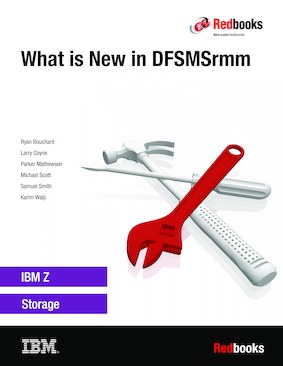Abstract
DFSMSrmm is an IBM z/OS feature that is a fully functioning tape management system to manage your removable media. In the last decade, many enhancements were made to DFSMSrmm. This IBM Redbooks publication is intended to help you configure and use the newer functions and features that are now available.
Discussion of the new features is included along with use cases. Hints and tips of various common DFSMSrmm problems and useful configuration and reporting JCL also are included.
This publication is intended as a supplement to DFSMSrmm Primer, SG24-5983, which is still the recommended starting point for any users new to DFSMSrmm.
Table of Contents
Chapter 1. External Data Manager function
Chapter 2. Retention methods in DFSMSrmm and the use of the expiration date
Chapter 3. Introduction to the Defaults Table
Chapter 4. Using SMS Management Class to assign tape expiration values
Chapter 5. Logical Write Once Read Many changes
Chapter 6. General Data Protection Regulation changes
Chapter 7. z/OSMF GUI plug-in for DFSMSrmm
Chapter 8. ONLYIF system option for EDGRMMxx
Chapter 9. CDSFULL command for EDGRMMxx
Chapter 10. Global Resource Serialization recommendations for RMM data sets
Chapter 11. Disaster Recovery and Disaster Recovery testing with the TS7700
Chapter 12. Partitioning examples with OPENRULE and PRTITION parameters
Chapter 13. Expire Hold setting and available scratch count
Chapter 14. Common problems in DFSMSrmm
Chapter 15. DFSORT JCL for use with DFSMSrmm
Appendix A. Using EDGRMMxx global defaults for assignment of retention attributes case study
Appendix B. Using Defaults Table for expiration attributes assignment case study
Appendix C. Using Management Class for assignment of expiration attributes case study
Appendix D. Using mixed retention methods VRSEL and EXPDT case study
Appendix E. Using Management Class and Defaults Table together case study
Appendix F. Using MCATTR(ALL) instead of MCATTR(VRSELXDI) case study
Appendix G. Key takeaways from the case studies
